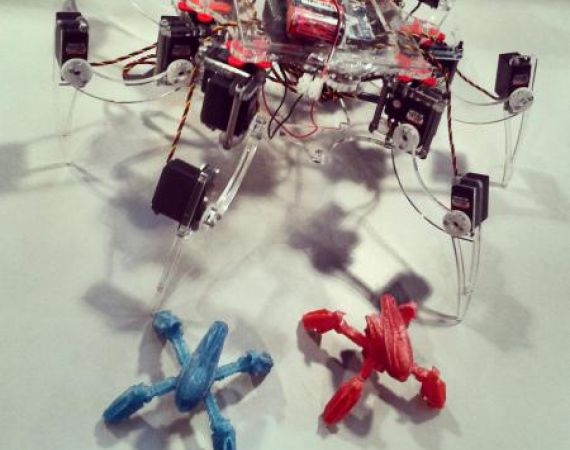Posted on Wed 6 Nov 2013
Reaching Robotics: Lunchtime Talk Write-up
Last Friday, one of our newest residents, Silas Adekunle came to the Studio equipped with some many-limbed plastic creatures to tell us about his start-up company Reach Robotics, and the future of toy robots.BeginningsSilas told us that from a young age he has been equally passionate about both…

Silas's hexopod and some 3D-printed toy prototypes
Last Friday, one of our newest residents, Silas Adekunle came to the Studio equipped with some many-limbed plastic creatures to tell us about his start-up company Reach Robotics, and the future of toy robots.
Beginnings
Silas told us that from a young age he has been equally passionate about both electronics and the beauty of nature. He loves the kind of robotics that strives to mimic the complexities of natural movement. The flames of Silas’s passion for all things robotic were fanned when he discovered Kismet – one of the first social robots with the capacity to make discernable human (ish..) facial expressions. Silas was so taken by this groundbreaking but discernably creepy looking robot that he longed to see how it worked. In order to do this, he built his own, which he said turned out to be even more disturbing! Silas studies Robotics at UWE and he has set up his own company; Reach Robotics.
Reach Robotics
Reach Robotics is one of four ‘xl’ projects funded by Prince’s Trust and a partnership between UWE and HP, which help young people engage with Robotics in a way that builds their confidence with STEM subjects. The program uses Lego Mindstorm NXT Robots, which have timeless design that allows for both simple and complex programming; making them perfect for first accessing the world of programming and robotics.
Aside from its educational undertaking, Reach Robotics is venturing into the toys and games spectrum. Silas has embarked on a project to create a new kind of robotic toy; a smart toy that evolves the more it is played with. Silas, being a fan of games like World of Warcraft, sees the importance of user potential, where a character can level up and get stronger/smarter/more agile. Many modern games have cottoned on to the popularity of this ‘evolution’ model and a high percentage of videogames have this as standard. The same however can’t quite be said for physical toys. Often, what comes out of the box is what you get; there is no opportunity for the toy to improve. In order to see the development of a physical toy, there needs to be a synchronicity of physical and digital. One of the first games that took the initiative to collide physical and digital was Skylander Giants, a videogame in which figurines are bought in order to unlock levels. These figurines are static however, and Silas sees that the next step in this physi-digital gaming phenomenon will be the emergence of interactive physical characters (robots) released alongside a virtual game. An example of where this has started to happen can be seen in Anki-Drive; a new app controlled racing game, where you control your physical car with your smart phone and you can earn points with which to upgrade your car’s virtual weapons. Your car learns and evolves the more it drives, and you can play against computers; an exciting mergence of traditional computer games and real world interaction. But Silas’s passion for natural movement has urged him to develop toy creatures, not toy cars.
‘Wheels are boring!’
Silas sees a fascinating complexity in both engineering and nature. He wishes to bring more of the natural engineering he has seen into the world of robotics – and this is why he aims to ditch the wheel. An intricate, multi-jointed leg is able to do so much more than a spinning wheel. Silas brought in a hexopod robot to demonstrate his point. The robot he brought in, built with an Arduino and a multitude of servos, was programmed to do a sort of dance performance for us. The complexity of its movement was undeniably striking, as Silas had programmed it to tap its legs on the glass table, move as if it was breathing heavily and raise two of its six legs in the air as though it was about to pounce. The robot was too spider-like for some, and it induced a few mentions of the ‘uncanny valley’. This brought Silas to tell us about his new robotic design, which has a less goose bump inducing four legs. Silas has started gathering a team in order to get his vision of a quadruped real/virtual toy off the ground. They have made a cat sized prototype in order to test possibilities of movement and interaction, but aim to reduce the final size of the product down to something smaller and more portable. Silas likened his plan for these robot toys to the Pokemon of the future, and children will be able to battle them with each other in a real world environment, controlling their creature and seeing it evolve on a smart phone app. Silas said that the possibilities for this kind of app guided real world interaction with robots will be limitless, and will definitely spill into education as well as play.
Silas will be working in the Studio for at least a month, and we can’t wait to see how his project develops while he’s here. Keep your eyes peeled for more news and updates concerning the Reach Robotics project on the PM Studio Website.